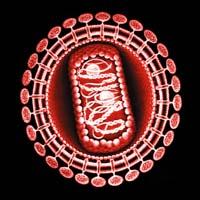AIDS, a fossil virus and mutants
2007/06/30 Galarraga Aiestaran, Ana - Elhuyar Zientzia

About 4 million years ago, a virus infected the chimpanzee and other primates. This caused the death of many chimpanzees. However, the man did not become infected, since he had his own resistance. However, the researchers have found that what at the time proposed to man resistance to this virus has now left us defenseless against the AIDS virus.
That virus was a retrovirus. Retroviruses have RNA and when they enter a cell, the RNA of the virus becomes DNA. This DNA is integrated into the cell genome, so that the infected cell makes copies of the virus. Throughout evolution, when going from generation to generation, retroviruses leave inheritance in DNA; in the end, the trace of the retrovirus is found in the DNA of the entire population. For example, about 8% of human DNA is inherited from viruses.
The researchers have shown that chimpanzees and other primates contain the footprint of a retrovirus now missing. Specifically, the chimpanzee has 130 copies of this virus in its DNA, while the man has none. Hence the researchers concluded that the retrovirus had infected the chimpanzee and close relatives, but not the man.
Bleeding in a protein
To demonstrate this hypothesis, the researchers took the inherited genes from the chimpanzee's DNA and joined them with a mouse retrovirus. In this way, retrovirus was regenerated 4 million years ago. Subsequently, retrovirus was introduced into a culture of human cells and showed that it could not infect cells. They also found that a protein containing human cells blocks the virus and does not allow it to be introduced into the cell.

Neither chimpanzee nor other nearby primates contain this protein, so they could not avoid infection. In this way, it should be thought that 4 million years ago the virus was going to be very damaged.
However, this protein, which at that time protected humans from infection, is useless against AIDS. On the other hand, nearby primates have another protein similar to this, which does protect them from AIDS. According to the researchers, somehow, the presence of this protein has weakened humans against AIDS; according to them, closing doors to a virus seems to open it to another.
Scientists have not yet fully revealed the relationship between protein and the ancient virus and intend to continue investigating. And it is that past infections are the same as our current immune system, and the more you know the past the better you will understand the present.
Protective mutation protective mutation
In fact, two years ago the researchers looked back to know more about AIDS. Then, however, they were not so far away, but at the Middle Ages. And it was not a question of finding out why the human being has no protection against AIDS, but on the contrary: they turned to the past to clarify what is what contributes to 10% of Europeans a certain resistance to AIDS.
The AIDS virus attacks white blood cells. However, one in ten Europeans suffers a mutation in a white blood cell protein. The protein is called CCR5 and, if not normal (if mutant), the virus cannot access the white blood cell. Therefore, those who have mutation have an advantage over AIDS.

Researchers do not know why so many people have that mutation in Europe, which is much rarer in other parts of the world. According to scientists, one option might be that this mutation hit Europe to protect it from another disease, and that is why it has spread. That is, as it once protected from another disease, those who had the mutation managed to get ahead and their descendants too. This would help expand the mutation.
With this hypothesis, the researchers wanted to know which disease was the key. They estimate that the mutation appeared about 2,500 years ago, long before the onset of AIDS. And it seems that some medieval epidemic contributed to the expansion of the mutation, which since then became much more habitual.
Scientists, like film detectives or novels, have investigated what medieval disease was and have two hypotheses. Some think that the plague was black, which contributed to the expansion of the mutation, and others that were considered marginalized.
The first hypothesis takes into account when and where the black plague outbreaks occurred, while the second hypothesis is based on the causal agent: the cause of smallpox is a virus and that of the black plague a bacterium. Therefore, it is more logical to think that the mutation that now protects from the AIDS virus spread because at that time it gave advantage to a virus.
At the moment they have not managed to test any of the hypotheses, but it is clear that in the past there is one of the keys to understanding the present. And it may also enter the lock of the door of the future!
Published in Gara.

Gai honi buruzko eduki gehiago
Elhuyarrek garatutako teknologia






